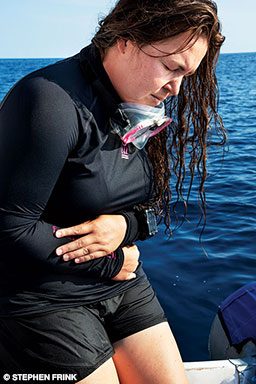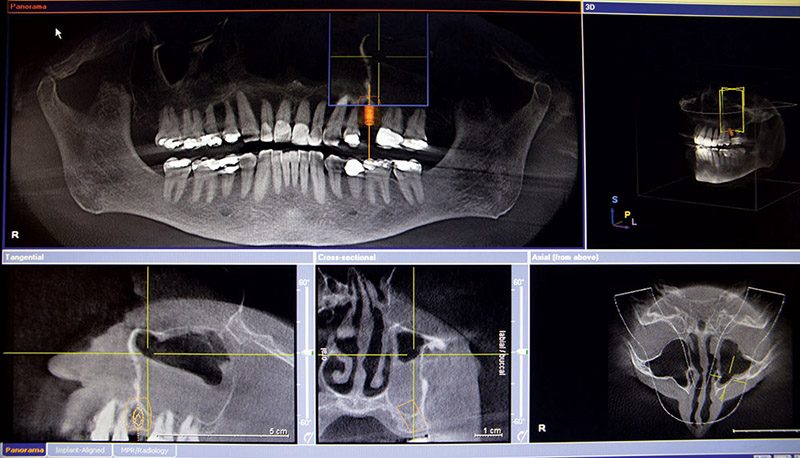DAN medical information specialists and researchers answer your dive medicine questions.
My daughter has Crohn’s disease and takes Remicade® every eight weeks. Are there any related issues that might prevent her from diving?

People with Crohn’s disease usually suffer from generalized ill health and frequent diarrhea interspersed with periods of remission. They may also experience abdominal pain, fevers and weight loss. Complications may include anemia, electrolyte imbalance, dehydration and general weakness. If a person is in a state of remission with well-controlled symptoms, then the illness should not be a contraindication for diving.
People who are suffering from any of the aforementioned symptoms, however, should refrain from diving. Remicade causes immunosuppression, which will predispose consumers to infections such as otitis externa (swimmer’s ear).
Patients should be cleared for diving by physicians who are familiar with their history and condition. Doctors who are inexperienced in dive medicine are welcome to consult with a DAN dive medicine physician.
— Sheryl Shea, RN, CHT

I’ve had a pinched nerve in my right thigh for several days without improvement. I’m in good physical shape and haven’t had any major medical issues. A scuba instructor suggested my wetsuit might have caused the pain. I usually dive in tropical waters with board shorts and a 3 mm top, but I recently purchased a 5 mm wetsuit for cold-water dives. It’s tight, but it’s a good fit and not too small. Do you think the wetsuit contributed to my pain?
The pain in your thigh is not likely related to a snug-fitting wetsuit. The type of pain you describe typically originates from deeper within the tissue and is more likely related to an injury or lifting and maneuvering heavy scuba gear.
If it’s possibly a dive-related injury, we recommend that you see a physician trained in dive medicine. DAN maintains a worldwide database of referral physicians, so please contact us at +1-919-684-2948 or at DAN.org/email for help finding a doctor near you.
— Sheryl Shea, RN, CHT
I recently had a sinus membrane lift with an underlying bone graft in my upper jaw to allow placement of a dental implant. Will I have any short- or long-term restrictions on diving?
Surgeons have not developed uniform recommendations related to oral surgery and scuba diving. Generally, the more complicated the surgery, the longer the wait before diving. Surgical complications, any underlying medical conditions, tobacco use and alcohol consumption can add to this waiting period.
During postsurgical osseointegration (fusion of the implant into the bone), it is necessary to avoid any activity that could apply pressure to the skin over the implant and cover screw or the healing abutment. Diving’s resultant pressure, no matter how slight, could damage the site if occurring too soon after surgery. If the regulator’s bite tabs are over the implant site, for example, transmitted biting forces can result in implant failure.

Diving should also be suspended for as long as it takes to avoid other complications associated with oral surgery: revascularization (resumption of blood flow), stabilization of the implant, oral and sinus cavity pressure changes, ability of the patient to hold a regulator in the mouth and use of medications for pain or infection.
Bone grafting procedures and sinus surgery are more complex and will require a longer waiting period. The larger the graft site, the longer the wait. Some doctors recommend avoiding any activity that causes micromovement for at least six months. It can take up to one year for complete bone healing at an implant site. Diving sooner than one year may not cause a problem, but your surgeon should determine the appropriate waiting period, and you should follow his or her advice.
— Marty McCafferty, EMT-P, DMT
I am currently taking a master scuba diver course. Our instructor wants us to dive an extended time at depth. Is that safe with regards to nitrogen buildup? I have an upcoming dive with the following profile:
130 feet: 20 minutes
98 feet: 2 minutes
65 feet: 2 minutes
40 feet: 4 minutes
30 feet: 5 minutes
20 feet: 6 minutes
10 feet: 16 minutes
Every time above 130 feet includes a one-minute ascent. Is this a safe profile, or should it be more conservative?
The profile you describe is within the limits of currently available dive tables and is slightly more conservative than the U.S. Navy dive tables. The dive profile is decompression (deco) diving, which requires decompression stops, and all these tables were developed for square profiles. I assume your instructor chose these times based on the dive tables of your training organization or a commercially available dive planner.
If you are concerned about an increased risk of decompression sickness (DCS), you can consider options to make the dive more conservative, such as the following:
- Add time to the shallower deco stops (e.g., another two minutes at 20 and 30 feet), and follow the ascent rates that your instructor proposed. Ascent rates are one of the main keys to safe decompression.
- Add enriched air nitrox (EAN) as a decompression gas starting on the deco stops to add oxygen to your decompression phase and speed up nitrogen elimination. Keep the same times as for the air profile, even if you switch to EAN.
- Decrease your bottom time by a few minutes.
It is always important to stay well hydrated before every dive, especially in deco diving.
For more information, read “Conservative Diving” (Alert Diver, Summer 2013) at AlertDiver.com/conservative_diving.
— Frauke Tillmans, Ph.D.
DAN’s guidelines for flying after diving are for cabin altitudes between 2,000 and 8,000 feet. What are the guidelines for divers who will be flying at altitudes outside of that range?
Most commercial flights keep cabin pressures between 2,000 and 8,000 feet (0.91–0.77 atmospheres). DAN has conducted and funded extensive human research to study the effects of exposures to those altitudes following different dive profiles and surface intervals. Researchers formulated guidelines at DAN’s Flying after Diving Workshop.

There is not enough data to give you precise recommendations on what to do outside that range, but if you consider that the lower the altitudes, the higher the cabin pressure, the less of a physiological insult (and vice versa), you could rationalize a sensible approach to mitigate the risks.
- For flights at cabin altitudes lower than 2,000 feet, you could theoretically have a slightly shorter surface interval before flying, but we suggest you follow the proven guidelines.
- For flights at cabin altitudes between 8,000 and 10,000 feet, you should consider hypoxia as an added stressor to the decompression stress induced by decreased barometric pressure. Without supplemental oxygen, you can control only the preflight interval, and rationale suggests the longer the better. A sensible approach to this scenario could be to double the recommended surface interval times for the preceding dive history: 24 hours instead of 12 hours for a single no-decompression dive; 36 hours instead of 18 hours for multiple days of diving or multiple dives a day; and about 48 hours for dives requiring mandatory decompression stops.
These studies did not consider situations in which a diver returns from a dive trip and lands at an airport located above 8,000 feet of altitude. For such cases we suggest at least doubling the recommended times for the preceding dive history.
— DAN Research and Medicine
© Alert Diver — Q2 2019